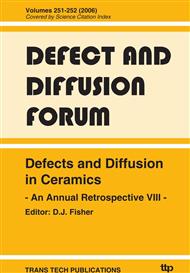p.51
p.59
p.69
p.79
p.89
p.97
p.105
p.111
p.123
Surface Microstructural Evolution up to Creep Rupture under the Power-Law Regime in Cu-8.5at%Al Alloy at Intermediate Temperatures
Abstract:
Micro-structural change caused by the corresponding change in creep properties of Cu-8.5at.%Al alloy was studied. It was found that a micro-structural observations reveal the formation of different types of defect features during creep of the investigated alloy at intermediate temperatures between 0.46-0.72Tm, where Tm is the absolute melting point. SEM was used to characterize the studied alloy by quantitative micro-analysis. It allowed the observer to defect the micro-structural features such as dislocation that were generated from deformation and could move interagranularly by glide and climb. Clearly, the development of this microstructure could be attributed to the grain refining effect of the Al indicating the role of the applied stress at this alloy. The results show that the creep rupture strength of Cu-8.5at.%Al alloy in the power law creep damage mechanism. This due to the constraint introduced on the matrix creep flow by the Al phase rather than the devolvement of high threshold stress values. While the increase in the length of Al filaments and reduction in interfilament spacing with increasing draw ratio increase the constraint on the creep flow of the matrix, they also enhance the creep damage caused by the diffusion mechanisms because of the easy diffusion paths along the Al filaments and the reduction in the matrix grain size.
Info:
Periodical:
Pages:
97-104
Citation:
Online since:
March 2006
Authors:
Price:
Сopyright:
© 2006 Trans Tech Publications Ltd. All Rights Reserved
Share:
Citation:


